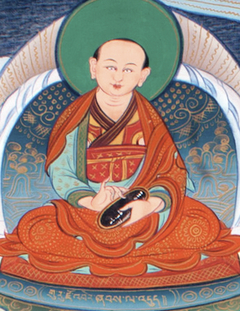Guru Jober Biography
Biography of the Dharma Lord Guru Jober
from the Vima Nyingtik[1]
The sun of compassion rose within the expanse resembling a cloudless sky,
And cleared away the opacity brought about by ignorance and delusion,
Whereby the light of awareness shone beyond eternalist and nihilist extremes,
And you brought the fortunate to buddhahood within a single lifetime—
Dharma Lord, Guru, to you I reverentially offer praise.
What follows is a brief biography of the Dharma Lord, Guru Jober. His father was Dawa Bum, the younger brother of Khepa Nyibum, and his mother was Gyalmo Alu.
Until his seventh year, he appeared to be mentally deficient. From his seventh year onward, his intelligence blossomed and became unimpeded, free from any kind of obstruction. From his eighth until his eighteenth year he received all the empowerments and instructions of the secret, unsurpassable teachings from his gracious uncle, Zhang Nyibum. Having studied all the tantras, he gave explanations of the Reverberation of Sound.
During his nineteenth and twentieth years, he studied the Three Continua, including all the related instructions, and the Malgyo tradition of Cakrasaṃvara with Sakya Lotsāwa. Then he studied the Compendium of Pramāṇa with Geshe Chumikpa.
In his twenty-second year he received Mitrayogin’s instructions from Trophu Lotsāwa. He also received various Mahāmudrā instructions from the Nepali Drakpa Bummé. Until his thirty-second year he undertook study and reflection, through which he arrived at a definitive understanding. He relied on numerous learned and noble teachers with whom he had made some form of Dharma connection.
He said that he had multiple visions of the deities depicted in all his thangka paintings and statues made of clay and metal. More specifically, when he went to offer lamps before the Jowo in Lhasa, he saw five-coloured rainbow light appear around the Jowo’s face. Four or five spheres of light poured from the statue’s mouth, and in their centre he saw Vajrapāṇi and consort and the Great Compassionate One [Avalokiteśvara]. On another occasion, at dawn, he saw the protector Amitāyus amidst flickering iridescent light. He later said, "It was seemingly by virtue of this that even though I have no tradition of longevity in my family, things have turned out well for me. Otherwise it could be the state of luminosity, the naturally arisen lamp. Since I possess such a teaching as this, transmitted from father to son, there can be no harm." Indeed, his unchanging body remained in an experience of great bliss, his unceasing speech taught the Dharma of definitive meaning, and his clear, empty wisdom mind remained serene in the freedom from extremes.
He passed beyond during the full moon in the first month of autumn in the year of the Rabbit. His body was surrounded by a web of rainbow light for a week, and his remains produced ringsel and featured the syllables āḥ and hūṃ and so on.
Ema! Wondrous and amazing, this flourishing Dharma,
Which stops the six classes of rebirth in this very lifetime,
And instantly banishes hopes and fears for saṃsāra and nirvāṇa—
Precious guru, holder of this supreme, definitive lineage,
Great sovereign, reveal the light of primordial wisdom.
It is complete.
| Translated by Adam Pearcey with the generous support of the Tsadra Foundation, 2024.
Bibliography
Tibetan Edition
klong chen rab 'byams pa dri med 'od zer. "chos bdag gu ru jo 'ber gyi rnam thar" In snying thig ya bzhi. 13 vols. Delhi: Sherab Gyaltsen Lama, 1975. Vol. 6: 420–423
Secondary Sources
Dudjom Rinpoche. The Nyingma School of Tibetan Buddhism. Translated by Gyurme Dorje and Matthew Kapstein. Boston: Wisdom, 1991.
Leschly, Jakob. "Guru Jober," Treasury of Lives, accessed February 06, 2024, https://treasuryoflives.org/biographies/view/Guru-Jober/8891.
Nyoshul Khenpo. A Marvelous Garland of Rare Gems. Translated by Richard Barron. Junction City, California: Padma Publication, 2005.
Version: 1.0-20240221
-
The precise authorship is unclear. Although the text appears in a recent edition of the collected writings of Longchen Rabjam, it does so only because the entire Nyingtik Yabzhi corpus is included. Likewise, it is included here within the Longchen Rabjam section of the website purely for the sake of convenience. ↩
